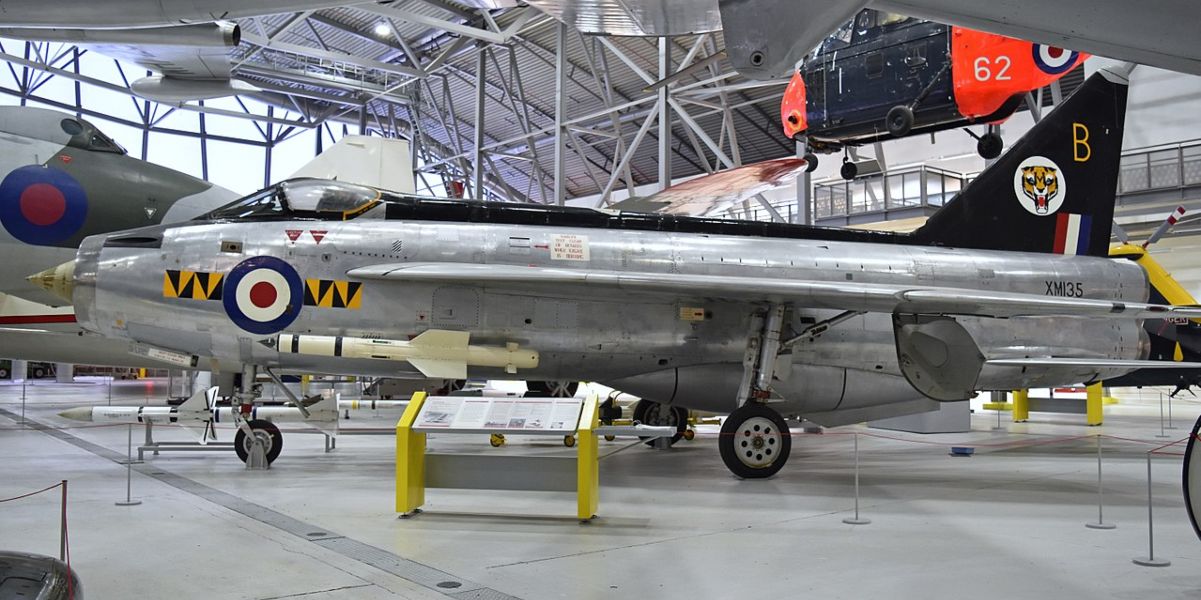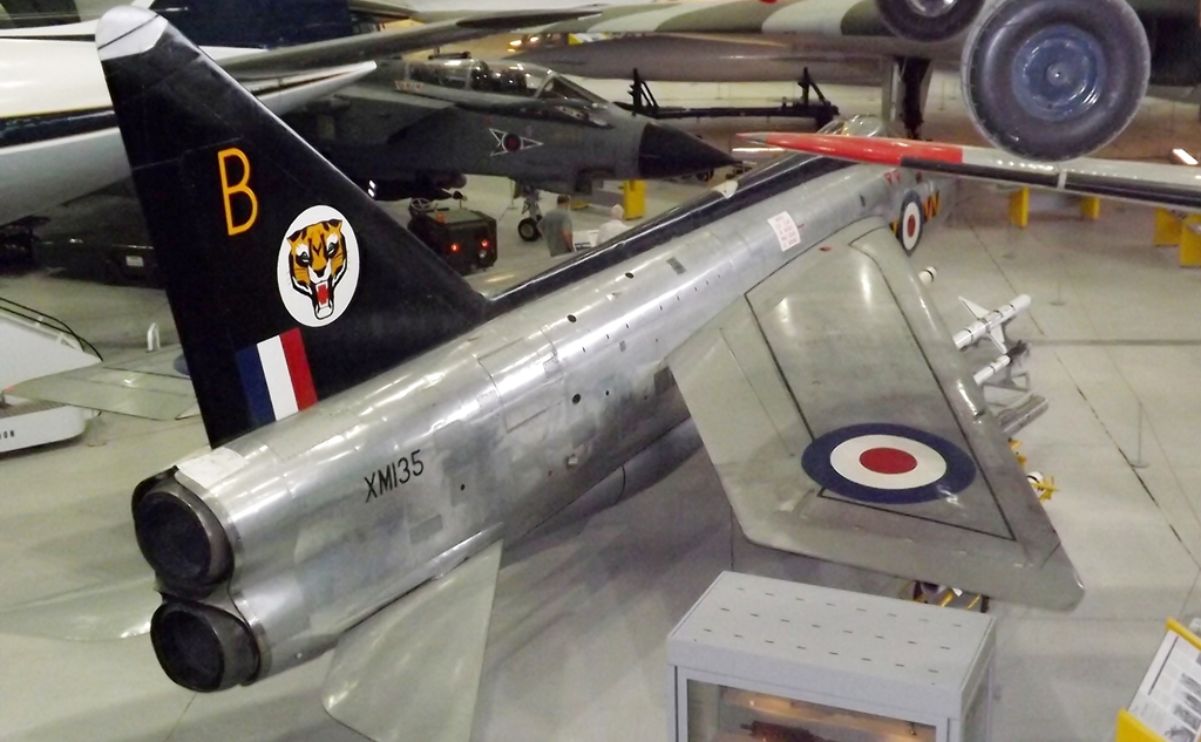The RAF Lighting Interceptor
Designed as a Mach 2 interceptor with an unrivaled rate of climb, the English Electric Lightning was frequently referred to as “a pilot sitting on two rockets” and was intended to defend the V-Force airfields during the Cold War.
According to Lightning pilot David Roome’s story in the book Lightning Boys, the official ceiling of the Lightning was reportedly over 60,000 feet, but he was able to achieve higher limits.
He recalls;
‘The RB-57F’s primary task on that visit Involved high altitude turbulence trials. However, the United States Air Force had consented to an additional mission (to use favored American terminology), which would exercise Singapore’s new, computerized air defense radar system. That was where I came in. The RB-57F would conduct a series of high-altitude target runs while two Lightnings, one of which would be flown by me, attempted to intercept it. By that stage, all of those concerned understood only too well that this would be no easy matter.
‘Further briefings took place before, at length, the time of trial arrived.
Intercepting a USAF RB-57F flying at 80,000 feet
‘The RB-57F took off just ahead of the Lightnings and set up for its first run at 50,000 feet. I carried out a successful intercept, then overtook the target from above; I just wanted to make the point that we Lightning pilots could operate in the upper atmosphere without difficulty. The target now turned through 180 degrees to set up for a second run. During this short turn, the pilot climbed up to 65,000 feet. This caused us some consternation when we realized that the RB-57F could climb to such an altitude in such a brief period of time.
However, determined not to be daunted, the other Lightning carried out a further successful interception then, as before, overtook the target from above. The target now announced that he would perform one orbit before he commenced his subsequent run. This time, he would be at 80,000 feet. It was my turn to carry out the interception.

Handling the Lightning with finesse
‘At these high altitudes, I had to handle my aircraft with particular finesse. The requisite technique was to accelerate the Lightning to supersonic air speeds at tropopause altitude (the boundary between troposphere and stratosphere, and the most efficient altitude for the Lightning’s Rolls-Royce Avon 302 engines), then zoom up to the target’s height for the interception. The tropopause, typically around 36,000 feet at European latitudes, was at its highest near the equator – regularly 55,000 feet or so. I would employ this to my advantage.
‘The use of supersonic flight meant, in turn, the use of reheat. However, with the aircraft’s attendant high fuel consumption in reheat, I had to use the facility as sparingly and as effectively as possible. When in supersonic flight, delicate use of the flight controls was essential; the temptation to overcontrol could lead to wildly inaccurate flying. Beyond Mach 1 (the speed of the sound barrier), the aerodynamic effect of supersonic flight masked the airframe buffet, but when at subsonic speeds, the least bit of rough handling at high altitudes would induce airframe buffet and loss of performance.
The highest possible altitude attainable by the Lightning
‘Despite these hazards, I accomplished a successful intercept of the target at 80,000 feet and I just managed to fly past the RB-57F at this altitude. Now came the final test… the big one.
‘The RB-57F crew stated that they would need a little more time to prepare for their last run which would beat an unstated (i.e. confidential) altitude in excess of 100.000 feet. This was well beyond our capability and we had to admit defeat. Nonetheless, I had an urge to find the highest possible altitude attainable by the Lightning Mark 6. For this, I would have to accelerate the Lightning to its maximum airspeed of Mach 2.2 before commencing the zoom climb. To achieve that would require full fuel tanks and mine were far from full after the earlier supersonic runs.
‘It was at this point that Lady Luck played a crucial to card. A Victor in-flight refueling tanker en route from Hong Kong to Singapore suddenly piped-up on the radio. “I’ve got some spare fuel,” announced the captain of the Victor. “Any takers?”
‘”Sure,” I replied at once. This was an incredible break; I wanted to stake my claim before anyone else got in ahead of me.
Lightning accelerating to Mach 2.2
‘The rendezvous with the tanker worked out well and, as arranged, I refueled my Lighting to full tanks. When I broke away from the Victor tanker, I selected the throttles to the full cold-power position and initiated a climb to 50,000 feet – the Lightning’s subsonic service ceiling. At that height, I rocked the twin throttles outboard and pushed them fully forward to select maximum reheat on both engines. As the Lightning accelerated through the sound barrier, I had to watch the Machmeter carefully: at these heights, there was nothing outside the cockpit to offer an impression of relative speed. Mach 1.1…, Mach 1.2…, Mach 1.3…, before long the indicator was edging up towards Mach 2.0.
‘Now I smoothly, and rather gingerly, pulled back the stick. My eyes narrowed with anxiety as I monitored the attitude indicator: I aimed for a nose-up attitude of exactly sixteen degrees, the best climb angle (so we had been told) for that height and speed. By 65,000 feet I was beginning to lose performance. I therefore levelled off to allow the aircraft to accelerate once more. Amazed by the rapidity at which this occurred, I decided to let the Lightning have its head. The aircraft accelerated to its maximum permitted speed of Mach 2.2 at which I eased back the stick again. At 70,000 feet, with no loss of airspeed, I pulled back the stick to resume a sixteen-degree angle of climb.

200 feet shy of 88,000 feet
‘Now I was entering new territory — for me, at least. As the Lightning climbed up, unfamiliar symptoms, some of them subtle, some not so subtle, began to make me feel a little ill at ease. For one thing, in order to hold sixteen degrees of climb, I had to bring the stick further and further back. I put this down to a lack of downwash over the tailplane at such exceptional altitudes. Gradually, as the Lightning, at last, appeared to run out of steam, the nose began to drop, and I was forced to level off. A quick s-check of my altimeter showed that I was just 200 feet shy of 88,000 feet.
‘I glanced outside the cockpit. The scene before me seemed surreal. Above, the sky was pitch black. To either side, the earth’s curvature was clearly perceptible. This was an uncommon sight in those days (Neil Armstrong’s moon landing was still a year or so away) and I felt awed, even humbled, by such solitary opportunity.
One fearful moment
‘I took stock of my situation. The stick was now firmly on the backstops. I had no further elevator control other than to lower the nose. The ailerons, interestingly, were still very responsive. Both reheats had remained alight until I touched the throttles. When I rolled the aircraft and looked down vertically, I suffered a strange, disconcerting sensation – a bit like being balanced on the ferrule of an infinitely long umbrella. Suddenly, I had the feeling that I did not belong up there. Musicians sometimes talk of how the music plays through them – is somehow separate from them, like an out-of-body experience.
‘That day, up there, I could empathize. I wanted to get down, I needed to initiate a descent. I therefore eased the Lightning’s throttles back to the idle/idle position. This, however, triggered the warning bell in my headset, which, in turn, gave me the one really fearful moment of the whole episode. The cockpit pressurization warning had been set off.
Ill-equipped for safe flight at extreme altitudes
‘Quickly, I tried to work out what was happening. I figured that a reduction in air output from the engine bleed had occurred when I closed the throttles. This had affected the cockpit pressurization, which, consequently, had placed the aircraft outside limits. With my pressure jerkin and anti-G suit, I had some protection, but the Taylor helmet initially issued to the Lightning force for high-level work had been taken out of service. There was some oxygen overpressure fed to my face mask, though not very much.
‘I realized that I was ill-equipped for safe flight at these extreme altitudes. Nonetheless, when I had worked out the cause of the cockpit warning, I began to reason with myself that the situation was not as serious as first assumed. I decided, therefore, to adopt a very long, slow glide back to Tengah. As a secondary benefit, this would allow me to continue to enjoy the remarkable view.
World altitude record of the Lightning
‘A last bit of fun came when I spoke with Singapore Radar, a unit manned by RAF personnel. I was asked my height, to which I replied ‘above flight level 450’ (which meant above 45,000 feet). In those days, almost all controlled airspace ended above that height and I was not required, therefore, to divulge my actual altitude. The controller, however, became persistent as I was approaching an airway. Eventually, when I revealed that I was passing flight level 720, his reaction caused me considerable amusement. On reflection, I realized that that call provided the only independent evidence of my claim to fame.
‘Despite this, I now officially lay claim to the world altitude record of the Lightning—87,800 feet. If anyone wishes to challenge this, let them speak now or forever hold their peace. As a serving member of 74(F) Squadron, I listened to a number of tiger tales (the squadron emblem was a tiger)—some of them authentic enough, some less so. My tiger tale may not be verifiable, and may not appear in the Guinness Book of World Records, nonetheless, this claim, to the best of my belief, is no mere paper tiger.’
Lightning Boys is published by Mortons Books and is available to order here.
Photo by Crown Copyright, Steve Fitzgerald, Alan Wilson from Stilton, Peterborough, Cambs, UK and Mark Harkin via Wikipedia


